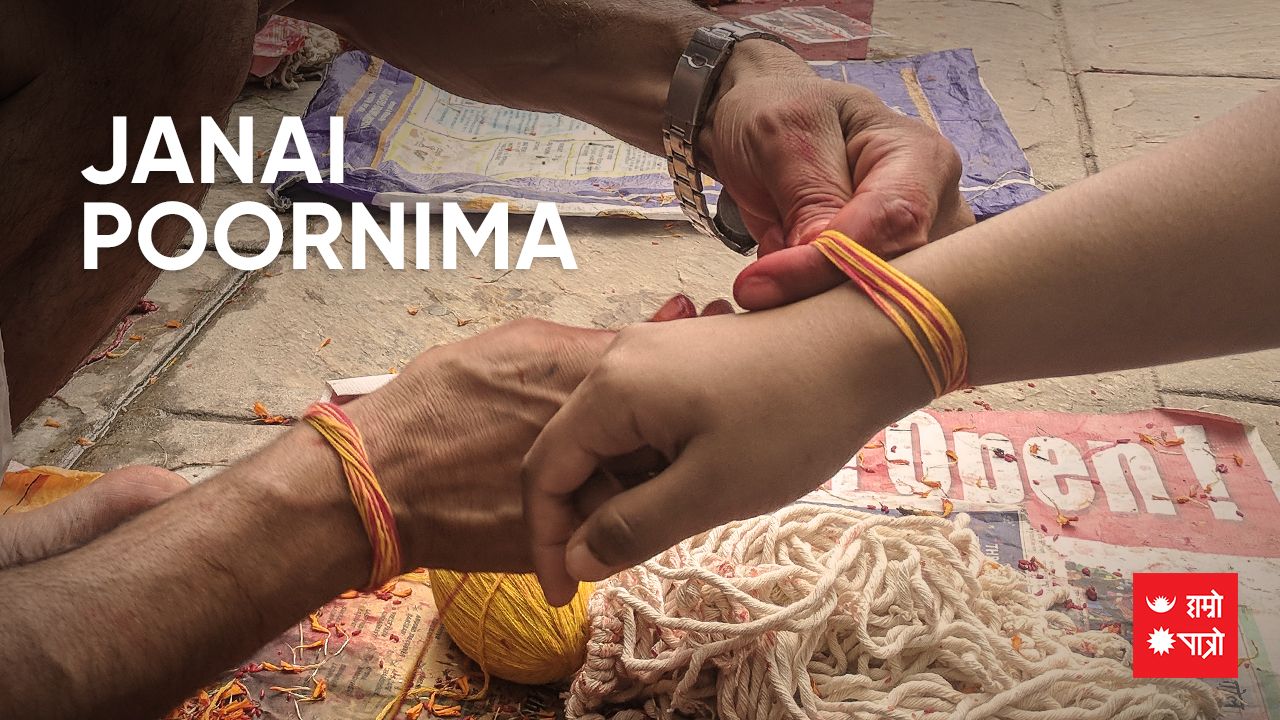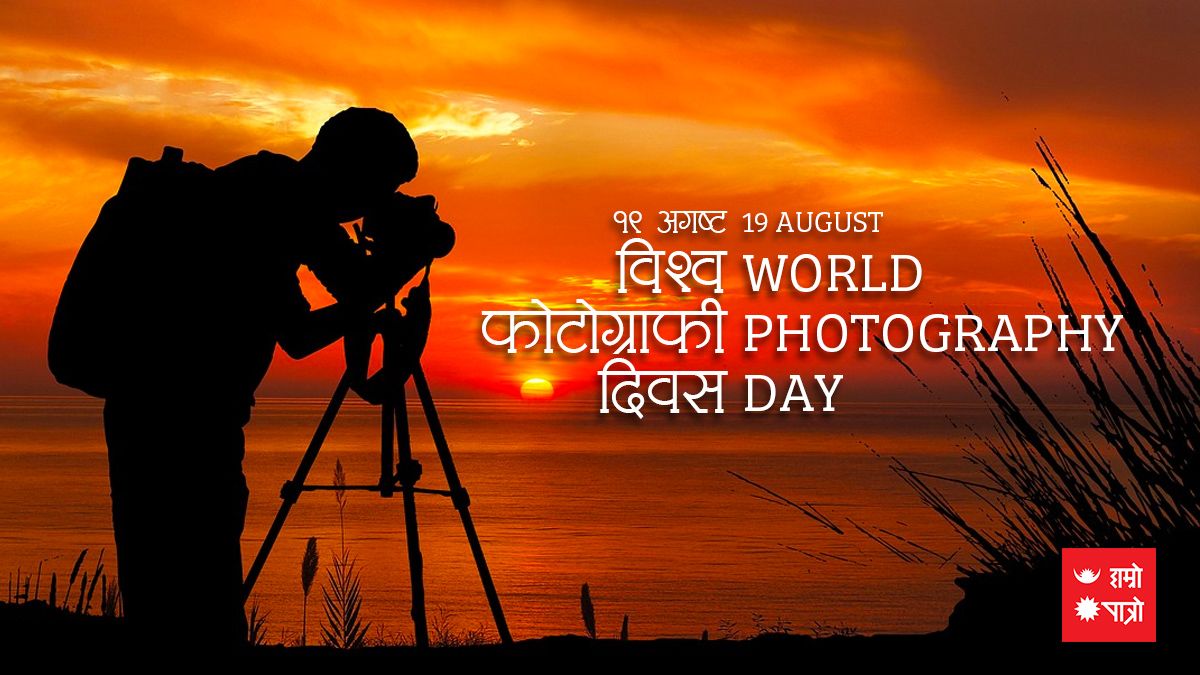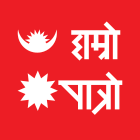Upcomming Events
-
29MangsirSafala Ekadashi Vrata tomorrow
-
1PaushDhanu Sankranti 2 days remaning
-
2PaushPradosh Vrata 3 days remaning
-
3PaushInternational Immigrants Day 4 days remaning
-
5PaushTol Lhosar 6 days remaning
-
6PaushWorld Meditation Day 7 days remaning
-
10PaushChristmas 11 days remaning
-
13PaushGorakhkali Puja 14 days remaning
-
15PaushTamu Lhosar/Kavi Siromani Lekhnath Jayanti/Putrada Ekadashi Vrata 16 days remaning
-
17PaushNew Year 2026/Pradosh Vrata/Topi Day/Poshak Day 18 days remaning
-
19PaushSri Swasthani Vrata Katha Prarambha/Maagh Snan/Poornima Vrata 20 days remaning
-
21PaushGuru Gobinda Singh Jayanti 22 days remaning
-
23PaushAraniko Smriti Day 24 days remaning
-
24PaushNepal Astrology Council Establishment Day 25 days remaning
-
27PaushPrithivi Jayanti/Rashtriya Ekata Diwas/Gorakhkali Puja 28 days remaning
-
29PaushNational Bhakka Day 30 days remaning
-
30PaushShattila Ekadashi 31 days remaning
-
1MaghMakar Sankranti/Ghiu chaku khane Din/Uttarayan Arambha 32 days remaning
-
2MaghNational Earthquake Safety Day/Pradosh Vrata 33 days remaning
-
5MaghSonam Lhochhar/Shree Ballav Jayanti 36 days remaning
-
8MaghTilkunda Chauthi 39 days remaning
-
9MaghBasanta Panchami vrata/Saraswati Pooja 40 days remaning
-
10MaghSkanda Sasti/Achala Saptami/International Day of Education 41 days remaning
-
11MaghGorakhkali Puja/World Leprosy Day 42 days remaning
-
12MaghInternational Custom Day 43 days remaning
-
13MaghDron Nawami 44 days remaning
-
15MaghBhima Ekadashi Vrata 46 days remaning
-
16MaghSahid Diwas/Pradosh Vrata 47 days remaning
-
18MaghShree Swasthani Brata Samapti/Poornima Wrata 49 days remaning
-
19MaghWorld Wetlands Day 50 days remaning
-
21MaghWorld Cancer Day 52 days remaning
-
25MaghRavisaptami Vrata 56 days remaning
-
26MaghGorakhkali Puja 57 days remaning
-
28MaghInternational Day of Women and Girls in Science/Safer Internet Day 59 days remaning
-
1FalgunKumbha Sankranti/Bijaya Ekadashi Vrata/World Radio Day 61 days remaning
-
2FalgunShani Pradosh Vrata/Valentine's Day 62 days remaning
-
3FalgunMaha-Shivaratri / Army Day/Silachahre Puja 63 days remaning
-
6FalgunGyalpo Lhosar 66 days remaning
-
7FalgunPrajatantra Diwas / Election Day 67 days remaning
-
8FalgunWorld Day of Social Justice 68 days remaning
Jyotish
-
Jyotish Vaman Sapkotaशिक्षा - व्याकरणाचार्य, पौरोही...
-
Jyotish Narayan Prasad Bhandariज्योतिषका उप-प्राध्यापक (lecturer of A...
-
 Jyotish Mukunda Sharmaस्वाध्याय, सत्सङ्ग र सदाचारजस�...
Jyotish Mukunda Sharmaस्वाध्याय, सत्सङ्ग र सदाचारजस�...
-
Jyotish Pandit Mukunda Nepalज्योतिष पण्डित मुकुन्द नेपाल�...
-
Jyotish Mohan Ghimireसम्पुर्णानन्द संस्कृत विश्वव...
-
Jyotish Damodar Poudelनेपाल संस्कृत विश्व बिद्यालय�...
-
Jyotish Amrit Paudelवाराणसीकै सम्पूर्णानन्द संस्...
-
Jyotish Purushottam Ghimireनेपाल संस्कृत विश्वविद्यालय, �...
-
Jyotish Smarika Acharyaबाल्मीकि बिद्यापिठ बाट ज्योत�...
-
Jyotish Krishna Prasad Bhandariउपप्राध्यापक (Asst. professor of Sanskrit) नेपा�...
-
 Jyotish Dharmendra Krishna Paudelशास्त्री धर्मेन्द्र कृष्ण पौ�...
Jyotish Dharmendra Krishna Paudelशास्त्री धर्मेन्द्र कृष्ण पौ�...
-
Jyotish Dipendra Khatiwadaसम्पुर्णानन्द संस्कृत बिश्वब...
-
Jyotish Narayan Prasad Gautamगुरुकुल शिक्षा प्रणालीबाट ज्�...
-
 Jyotish Kuresh Pandey११ वर्षको अनुभवसहित विभिन्न ध�...
Jyotish Kuresh Pandey११ वर्षको अनुभवसहित विभिन्न ध�...
-
Jyotish Deepak Prasad Kafleसम्पूर्णानन्द संस्कृत विश्वव...
-
Jyotish Damodar Kaushikज्योतिष र व्याकरण विषयमा आचार�...
-
Jyotish Ghanashyam Pokharelनेपाल संस्कृत विश्वविद्यालयब...
-
Jyotish Khageshwor Subediगुरुकुल पद्दति बाट ज्योतिषीय �...
-
Acharya Choodamani Pathakसम्पूर्णानन्दसंस्कृत विश्वव�...
-
Jyotish Dr. Janak Bhattaविगत ३५ वर्षदेखि कुण्डली निर्�...
-
Jyotish Khagendra Subediसम्पूर्णानंद संस्कृत विश्ववि...
Hororscope
साउन शुक्ल पूर्णिमा
Janai Poornima | Rakshya Bandhan | Kwati Khane Din | Rishi Tarpani | Sanskrit Diwas | World Photography Day | Poornima Vrata

Janai Poornima: The thread of security and purity
Now the convoy of festivals has started to come to add more joy in the happy time after planting. It's time to sigh after planting, festivals add a different color to life.
The festival of happiness, especially the colorful rakhis, has added sparkle to the shops. And if you are a sister, you bought it for your brothers? And what kind of gifts do the brothers have for their sisters today?
Every festival has its significance and context like some are festivals commemorating the importance of soil, the festival of water, and today it is a festival of thread and bondage in Janapurnima. The thread is bondage, a bond of holiness and security.
Yanjnopawit- its making and significance in Sanatana Philosophy
According to Hindu tradition, Brahmins and Kshatriya men have been wearing Yajnopavit, i.e. Janai. After chanting the Gayatri mantra in the ears of the boy (Batuk) by the Guru-Purohit after performing the ritual vratbandha karma, it is accepted that the Guru Purohit has prepared the mantra by placing it under the right hand on the left shoulder with a firm resolve to follow the path of
In this way, all the 6 raw threads (6 yarn threads) of the mantra are made by tying two separate knots and putting them all in one place.
A tradition of changing Janai annually to this day is accustomed from ancient time. Of the six crests of the two crests in Janai, the three cords in one crest are considered to be Brahma, Vishnu and Maheshwar and the three cords in the other crest are considered to be the sum of karma, worship and knowledge.
The Mantra for today
"येन बद्धो वलीराजा दानवेन्द्रो महावलस् ।
तेन त्वां प्रतिबध्नामि रक्षे मा चल मा चल ।।"
The defense (raw thread) that bound the great king of demons, Vali, I will bind you with the same thread, this defense bond will protect you forever.
Gumpunhi
Today is also called Gumpunhi in Nepal Bhasa. The Newa community celebrates this day as "Punhi of Gunla Mahina" meaning "Gumpunhi". On this occasion, a statue of Dipankar Buddha and other related statues called 'Bahidya: Boyegu' are displayed in Bahal Vihar in the inner city of the Kathmandu valley.
Rakshabandhan
The festival is made up of two words, namely "Raksha" and "Bandhan." As per the Sanskrit terminology, the occasion means "the tie or knot of protection" where "Raksha" stands for the protection and "Bandhan" signifies the verb to tie. Together, the festival symbolizes the eternal love of brother-sister relationship. Sisters tie colorful threads on their brothers' wrists and put dots of vermilion paste on their brothers' foreheads while praying for them to live a long life. Brothers, in turn, give their sisters gifts-usually a piece of jewelry or clothing, or perhaps some money-while promising to protect them throughout their lives. In families where there are only boys or only girls, a friend or relative is asked to act as a brother or sister during the festival. According to Hindu tradition, it is believed that doing so will bring goodness. Some of them go to the Guru Purohit themselves or go to the temple to tie the Rakshabandhan. It is also customary to take out the thread tied and wrap it around the tail of a cow, later if one feels like untying the thread.
On this day, sisters tie colorful threads and flowers on the right wrists of their brothers and wish them longevity and success. Rakhi is very popular in the Tarai region of Nepal, India, Bangladesh, and other countries and the importance of this festival is very high.
Gatherings today
Nowadays, it is customary for the son-in-law to go to the in-laws and change Janai. Today, religious gatherings are being held at Pashupatinath of Kathmandu, Kumbheshwar Mahadev of Bhaktapur, Gosainkund of Rasuwa, Gangasagar, Dhanush Sagar of Janakpur, Dudhkund of Solukhumbu, Halesi of Khotang, Dansadhu of Jumla, Nagarkot and other Mahadevsthan and Trivenidhams.
Especially in the community of Brahmins, Kshatriyas, or any other Vedic religion followers, it is celebrated on the full moon by putting mantra integrated sacred Janai from the hands of Brahmin priests.
Remember that wearing the mantras of Yajnopavitas is believed to give direct energy to the Savitha, i.e. the Sun God, and to increase the physical, mental, and spiritual strength by chanting the Gayatri mantra. At the same time, after wearing the Yajna, one is qualified to become the doer and engineer of all eternal deeds. Nowadays, Vedic Sanatan Dharma is considered as an ethnic basis and untouchability, which is just a very narrow frustration.
Yajnopavit acts as a passport to the Brahmanpath, but Brahmanpath is not a path to birth but a path to karma. The Brahmanical path is the path of spiritual purity, goodness of the whole world, and study. Brahmins should not be seen only as caste, language, and creed. Regardless of one's religion or ethnic background, one can adhere to the Brahmanical path of study and spiritual purity. May we all be protected and stay positive.
Kwati day: A specific dish
A special dish that should not be missed in this festival is "Kwati" made from soaked and sprouted beans. In Nepal language, Kwati means 'Kwa:' which means hot dish, 'Ti' means liquid. Nine types of beans compose this exclusively nutritious dish, this day is the day for this dish and taste. The green sprouted beans are cooked and eaten especially as a liquid vegetable and it is also an important flavor of the day. Kwati has its way of cooking, some cook that as it is and some mix meats and other vegetables to it.
Today, there is a belief that if you eat Kwati, you will get rid of various diseases related to digestion. A special type of Kwati eaten by the Newar community is called "Nwangi". Whether in the country or abroad, with family or outside the family, either you believe in any religion or not? May Janai Poornima touches you with the wave of purity. May this ancient culture of the raw thread continue as a symbol of unconditional love, harmony, and protection for all.
Sanskrit Diwas
World Sanskrit Day is celebrated on Janai Purnima every year to bring the objective importance of Sanskrit language to the public and to research the vast knowledge in Sanskrit literature, to motivate the intellectual community towards it, and to inspire students to study the Sanskrit language. Since the Vedas are recited on the day of Shravan Purnima, the day of Sanskrit language which has a history of more than 5000 years, this day is celebrated as Sanskrit Day.
Today, World Sanskrit Day is being celebrated by organizing various programs to spread knowledge in the texts written in the Sanskrit language. World Sanskrit Day is being celebrated for the promotion and promotion of Sanskrit language. Even though the love for Sanskrit language is not so much in the youth of today, it is being celebrated with the idea of establishing the love of Sanskrit language among the younger generation. Today, various programs are organized for Sanskrit Jagran or awareness across the country.
Rishi Tarpani
Janai Purnima is also called Rishi Tarpani because Tagadhari offers tarpan to seven sages including Kashyapa, Atri, Bharadwaja, Gautama, Jamadagni, Vishwamitra and Arundhati.
All the followers of Sanatana Dharma have sages as their ancestors and according to this the gotras of all have been decided according to the names of those sages. In this sense, the tarpan given these days is the memory of our unique ancestors and synonymous with our clan traditions and rituals.
May everyone be protected, best wishes.
World Photography Day
World Photography Day is celebrated annually on August 19th. In 2024, it will be observed on Monday, August 19. This day commemorates the art, science, and history of photography and encourages photographers from around the globe to share their work and experiences.
Theme 2024: An entire day
Why is August 19 photography day?
The day is held August 19th as it's the date in 1839 that the government in France purchased the patent for the Daguerreotype process. The French government called the invention of the Daguerreotype process a free gift to the world.
Best wishes on this day.
Poornima Vrata
The last day of Shukla Paksha is the full moon day. On this tithi, the moon is the brightest and magnificent. It is believed that fasting on this day brings immense lunar grace to health, prosperity, and peace. On the full moon day, Lord Shiva and Vishnu are especially worshiped. Special worship to Lord Vishnu is done in the form of Satya Narayan Puja. Satya Narayan Puja is usually performed whenever possible, although the fruits of this puja performed on the day of the full moon are very abundant.
From a scientific point of view, it is said that gravity will have a great effect on the earth on the day of the full moon and self-purification will be done by fasting on this day and remembering the name of God. By fasting on this day, the metabolic process will be strengthened, gastric problems will be solved and positive energy will increase in the body.
This day is fasted from sunrise in the morning to moonrise in the evening. Some people observe this fast without drinking water, while others observe this fast by eating only one meal and eating no salt (alino) food. In the evening, after the moonrise, the fast ends with the sighting of the moon.
Let there be an end to the flood and landslide, let there be the protection of both religion and the followers of religion.
-Suyog Dhakal
Upcomming Events
-
29MangsirSafala Ekadashi Vrata tomorrow
-
1PaushDhanu Sankranti 2 days remaning
-
2PaushPradosh Vrata 3 days remaning
-
3PaushInternational Immigrants Day 4 days remaning
-
5PaushTol Lhosar 6 days remaning
-
6PaushWorld Meditation Day 7 days remaning
-
10PaushChristmas 11 days remaning
-
13PaushGorakhkali Puja 14 days remaning
-
15PaushTamu Lhosar/Kavi Siromani Lekhnath Jayanti/Putrada Ekadashi Vrata 16 days remaning
-
17PaushNew Year 2026/Pradosh Vrata/Topi Day/Poshak Day 18 days remaning
-
19PaushSri Swasthani Vrata Katha Prarambha/Maagh Snan/Poornima Vrata 20 days remaning
-
21PaushGuru Gobinda Singh Jayanti 22 days remaning
-
23PaushAraniko Smriti Day 24 days remaning
-
24PaushNepal Astrology Council Establishment Day 25 days remaning
-
27PaushPrithivi Jayanti/Rashtriya Ekata Diwas/Gorakhkali Puja 28 days remaning
-
29PaushNational Bhakka Day 30 days remaning
-
30PaushShattila Ekadashi 31 days remaning
-
1MaghMakar Sankranti/Ghiu chaku khane Din/Uttarayan Arambha 32 days remaning
-
2MaghNational Earthquake Safety Day/Pradosh Vrata 33 days remaning
-
5MaghSonam Lhochhar/Shree Ballav Jayanti 36 days remaning
-
8MaghTilkunda Chauthi 39 days remaning
-
9MaghBasanta Panchami vrata/Saraswati Pooja 40 days remaning
-
10MaghSkanda Sasti/Achala Saptami/International Day of Education 41 days remaning
-
11MaghGorakhkali Puja/World Leprosy Day 42 days remaning
-
12MaghInternational Custom Day 43 days remaning
-
13MaghDron Nawami 44 days remaning
-
15MaghBhima Ekadashi Vrata 46 days remaning
-
16MaghSahid Diwas/Pradosh Vrata 47 days remaning
-
18MaghShree Swasthani Brata Samapti/Poornima Wrata 49 days remaning
-
19MaghWorld Wetlands Day 50 days remaning
-
21MaghWorld Cancer Day 52 days remaning
-
25MaghRavisaptami Vrata 56 days remaning
-
26MaghGorakhkali Puja 57 days remaning
-
28MaghInternational Day of Women and Girls in Science/Safer Internet Day 59 days remaning
-
1FalgunKumbha Sankranti/Bijaya Ekadashi Vrata/World Radio Day 61 days remaning
-
2FalgunShani Pradosh Vrata/Valentine's Day 62 days remaning
-
3FalgunMaha-Shivaratri / Army Day/Silachahre Puja 63 days remaning
-
6FalgunGyalpo Lhosar 66 days remaning
-
7FalgunPrajatantra Diwas / Election Day 67 days remaning
-
8FalgunWorld Day of Social Justice 68 days remaning
Jyotish
-
Jyotish Vaman Sapkotaशिक्षा - व्याकरणाचार्य, पौरोही...
-
Jyotish Narayan Prasad Bhandariज्योतिषका उप-प्राध्यापक (lecturer of A...
-
 Jyotish Mukunda Sharmaस्वाध्याय, सत्सङ्ग र सदाचारजस�...
Jyotish Mukunda Sharmaस्वाध्याय, सत्सङ्ग र सदाचारजस�...
-
Jyotish Pandit Mukunda Nepalज्योतिष पण्डित मुकुन्द नेपाल�...
-
Jyotish Mohan Ghimireसम्पुर्णानन्द संस्कृत विश्वव...
-
Jyotish Damodar Poudelनेपाल संस्कृत विश्व बिद्यालय�...
-
Jyotish Amrit Paudelवाराणसीकै सम्पूर्णानन्द संस्...
-
Jyotish Purushottam Ghimireनेपाल संस्कृत विश्वविद्यालय, �...
-
Jyotish Smarika Acharyaबाल्मीकि बिद्यापिठ बाट ज्योत�...
-
Jyotish Krishna Prasad Bhandariउपप्राध्यापक (Asst. professor of Sanskrit) नेपा�...
-
 Jyotish Dharmendra Krishna Paudelशास्त्री धर्मेन्द्र कृष्ण पौ�...
Jyotish Dharmendra Krishna Paudelशास्त्री धर्मेन्द्र कृष्ण पौ�...
-
Jyotish Dipendra Khatiwadaसम्पुर्णानन्द संस्कृत बिश्वब...
-
Jyotish Narayan Prasad Gautamगुरुकुल शिक्षा प्रणालीबाट ज्�...
-
 Jyotish Kuresh Pandey११ वर्षको अनुभवसहित विभिन्न ध�...
Jyotish Kuresh Pandey११ वर्षको अनुभवसहित विभिन्न ध�...
-
Jyotish Deepak Prasad Kafleसम्पूर्णानन्द संस्कृत विश्वव...
-
Jyotish Damodar Kaushikज्योतिष र व्याकरण विषयमा आचार�...
-
Jyotish Ghanashyam Pokharelनेपाल संस्कृत विश्वविद्यालयब...
-
Jyotish Khageshwor Subediगुरुकुल पद्दति बाट ज्योतिषीय �...
-
Acharya Choodamani Pathakसम्पूर्णानन्दसंस्कृत विश्वव�...
-
Jyotish Dr. Janak Bhattaविगत ३५ वर्षदेखि कुण्डली निर्�...
-
Jyotish Khagendra Subediसम्पूर्णानंद संस्कृत विश्ववि...
Hororscope
Liked by:




















 Mesh
Mesh Brish
Brish Mithun
Mithun Karkat
Karkat  Singha
Singha  Kanya
Kanya Tula
Tula Brischik
Brischik Dhanu
Dhanu  Makar
Makar  Kumbha
Kumbha Meen
Meen